Stewart J. Calculus
Подождите немного. Документ загружается.

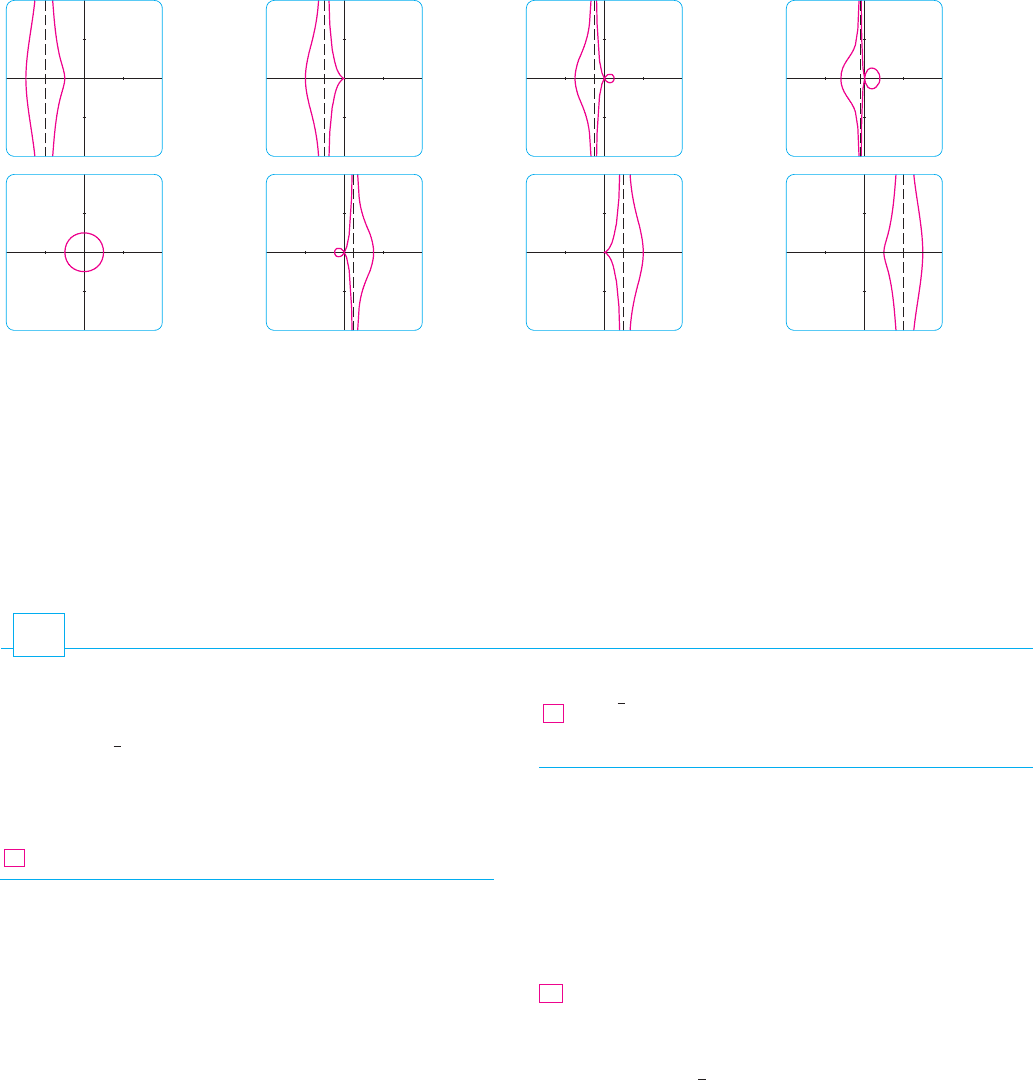
SOLUTION We use a graphing device to produce the graphs for the cases , ,
, , , , , and shown in Figure 17. Notice that all of these curves (except
the case ) have two branches, and both branches approach the vertical asymptote
as approaches from the left or right.
When , both branches are smooth; but when reaches , the right branch
acquires a sharp point, called a cusp. For between and 0 the cusp turns into a loop,
which becomes larger as approaches 0. When , both branches come together and
form a circle (see Example 2). For between 0 and 1, the left branch has a loop, which
shrinks to become a cusp when . For , the branches become smooth again,
and as increases further, they become less curved. Notice that the curves with posi-
tive are reflections about the -axis of the corresponding curves with negative.
These curves are called conchoids of Nicomedes after the ancient Greek scholar
Nicomedes. He called them conchoids because the shape of their outer branches
resembles that of a conch shell or mussel shell.
M
ay
aa
a ' 1a ! 1
a
a ! 0a
!1a
!1a
a
&
!1
a=_2 a=_1 a=_0.5 a=_0.2
a=2a=1a=0.5a=0
axx ! a
a ! 0
210.50!0.2!0.5
!1a ! !2
8. ,
,
10. ,
11–18
(a) Eliminate the parameter to find a Cartesian equation of the
curve.
(b) Sketch the curve and indicate with an arrow the direction in
which the curve is traced as the parameter increases.
11. , ,
12. , ,
, ,
14. ,
15. ,
16. , ,
17. , y ! cosh tx ! sinh t
t ( 1y !
s
t
x ! ln t
y ! t " 1x ! e
2t
y ! e
2t
x ! e
t
! 1
0
&
t
&
#
%2y ! csc tx ! sin t
13.
!
#
%2 $
%
$
#
%2y ! 5 sin
%
x ! 4 cos
%
0 $
%
$
#
y ! cos
%
x ! sin
%
y ! t
3
x ! t
2
y ! 1 ! tx !
s
t
9.
y ! 2 ! t
2
x ! 1 " 3t
1– 4 Sketch the curve by using the parametric equations to plot
points. Indicate with an arrow the direction in which the curve is
traced as increases.
1. , ,
2. , ,
3. , ,
, ,
5–10
(a) Sketch the curve by using the parametric equations to plot
points. Indicate with an arrow the direction in which the curve
is traced as t increases.
(b) Eliminate the parameter to find a Cartesian equation of
the curve.
5. ,
6. , ,
7. , , !3 $ t $ 4y ! 5 ! 2tx ! t
2
! 2
!2 $ t $ 3y ! 5 ! 2tx ! 1 " t
y ! 2t " 1x ! 3t ! 5
!2 $ t $ 2y ! e
t
! tx ! e
!t
" t
4.
!
#
$ t $
#
y ! t
2
x ! 5 sin t
0 $ t $ 2
#
y ! t ! cos tx ! 2 cos t
0 $ t $ 5y ! t
2
! 4 tx ! 1 "
s
t
t
E X E R C I S E S
11.1
662
|| ||
CHAPTER 11 PARAMETRIC EQUATIONS AND POLAR COORDINATES
F I G U R E 1 7 Members of the family
x=a+cost, y=atant+sint,
all graphed in the viewing rectangle
!_4,4$ by !_4,4$
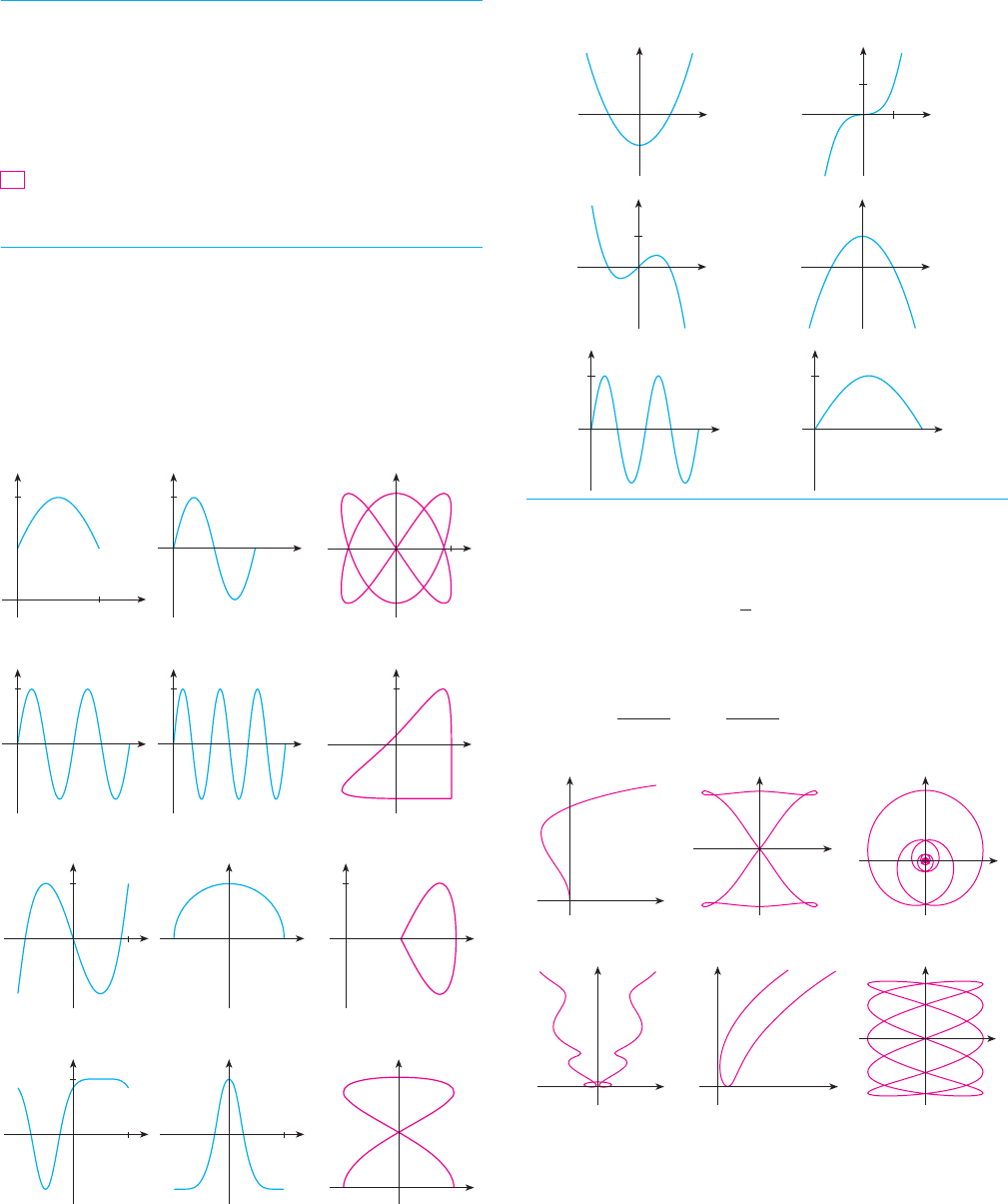
25–27 Use the graphs of and to sketch the
parametric curve , . Indicate with arrows the
direction in which the curve is traced as increases.
25.
26.
27.
28. Match the parametric equations with the graphs labeled I-VI.
Give reasons for your choices. (Do not use a graphing
device.)
(a) ,
(b) ,
(c) ,
(d) ,
(e) ,
(f) ,
;
29. Graph the curve .
;
30. Graph the curves and and find their
points of intersection correct to one decimal place.
x ! y"y ! 1#
2
y ! x
5
x ! y ! 3y
3
" y
5
x
y
x
y
x
y
x
y
x
y
x
y
I II III
IV V VI
y !
cos 2t
4 " t
2
x !
sin 2t
4 " t
2
y ! t
2
" cos 3tx ! t " sin 4t
y ! sin 2tx ! cos 5t
y ! sin"t " sin 2t#x ! sin 2t
y !
s
t
x ! t
2
! 2t
y ! t
2
x ! t
4
! t " 1
t
y
1
1
t
x
1
1
t
x
1
1
t
y
1
1
t
x
_1
1
t
y
1
1
t
y ! t"t#x ! f "t#
y ! t"t#x ! f "t#
18. ,
19–22 Describe the motion of a particle with position as
varies in the given interval.
19. , ,
20. , ,
, ,
22. , ,
23.
Suppose a curve is given by the parametric equations
,
, where the range of is and the range of is
. What can you say about the curve?
24. Match the graphs of the parametric equations and
in (a)–(d) with the parametric curves labeled I–IV.
Give reasons for your choices.
(c) III
t
2
2
yx
t
2
2
(d) IV
t
2
2
yx
t
2
2
y
x
2
2
1
y
x
1
2
t
x
2
1
1
t
y
1
1
y
x
2
2
(a) I
(b) II
x
t
2
1
t
2
1
y y
x
2
2
y ! t"t#
x ! f "t#
!2 , 3$
t!1, 4$fy ! t"t#
x ! f "t#
!2
#
$ t $ 2
#
y ! cos
2
tx ! sin t
!
#
$ t $ 5
#
y ! 2 cos tx ! 5 sin t
21.
0 $ t $ 3
#
%2y ! 4 " cos tx ! 2 sin t
#
%2 $ t $ 3
#
%2y ! 1 " 2 sin tx ! 3 " 2 cos t
t
"x, y#
y ! 5 sinh tx ! 2 cosh t
SECTION 11.1 CURVES DEFINED BY PARAMETRIC EQUATIONS
|| ||
663
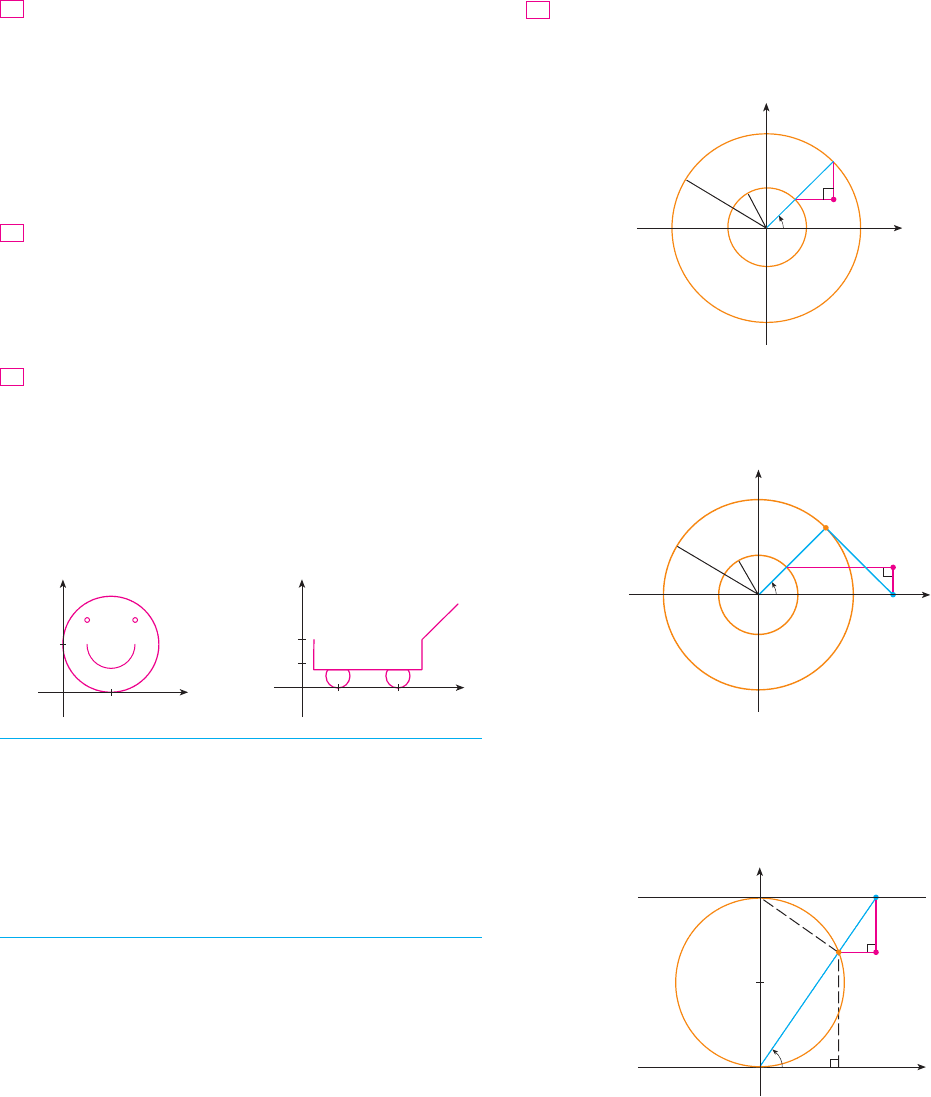
If and are fixed numbers, find parametric equations for
the curve that consists of all possible positions of the point
in the figure, using the angle as the parameter. Then elimi-
nate the parameter and identify the curve.
42. If and are fixed numbers, find parametric equations for
the curve that consists of all possible positions of the point
in the figure, using the angle as the parameter. The line seg-
ment is tangent to the larger circle.
43. A curve, called a witch of Maria Agnesi, consists of all pos-
sible positions of the point in the figure. Show that para-
metric equations for this curve can be written as
Sketch the curve.
44. (a) Find parametric equations for the set of all points as
shown in the figure such that . (This curve
is called the cissoid of Diocles after the Greek scholar
Diocles, who introduced the cissoid as a graphical method
for constructing the edge of a cube whose volume is twice
that of a given cube.)
&
OP
&
!
&
AB
&
P
O
x
a
A
P
y=2a
¨
y
C
y ! 2a sin
2
%
x ! 2a cot
%
P
O
x
y
¨
a
b
A
B
P
AB
%
P
ba
O
y
x
¨
a
b
P
%
P
ba
41.
(a) Show that the parametric equations
where , describe the line segment that joins the
points and .
(b) Find parametric equations to represent the line segment
from to .
;
32. Use a graphing device and the result of Exercise 31(a) to
draw the triangle with vertices , , and .
Find parametric equations for the path of a particle that
moves along the circle in the manner
described.
(a) Once around clockwise, starting at
(b) Three times around counterclockwise, starting at
(c) Halfway around counterclockwise, starting at
;
(a) Find parametric equations for the ellipse
. [Hint: Modify the equations of
the circle in Example 2.]
(b) Use these parametric equations to graph the ellipse when
and b ! 1, 2, 4, and 8.
(c) How does the shape of the ellipse change as b varies?
;
35 –36 Use a graphing calculator or computer to reproduce the
picture.
35. 36.
37–38 Compare the curves represented by the parametric equa-
tions. How do they differ?
37. (a) , (b) ,
(c) ,
38. (a) , (b) ,
(c) ,
39. Derive Equations 1 for the case .
40. Let be a point at a distance from the center of a circle of
radius . The curve traced out by as the circle rolls along a
straight line is called a trochoid. (Think of the motion of a
point on a spoke of a bicycle wheel.) The cycloid is the spe-
cial case of a trochoid with . Using the same parameter
as for the cycloid and, assuming the line is the -axis and
when is at one of its lowest points, show that
parametric equations of the trochoid are
Sketch the trochoid for the cases and .d ' rd
&
r
y ! r ! d cos
%
x ! r
%
! d sin
%
P
%
! 0
x
%
d ! r
Pr
dP
#
%2
&
%
&
#
y ! e
!2t
x ! e
t
y ! sec
2
tx ! cos ty ! t
!2
x ! t
y ! e
!2t
x ! e
!3t
y ! t
4
x ! t
6
y ! t
2
x ! t
3
0
y
x
2
3 8
4
0
2
y
x
2
a ! 3
x
2
%a
2
" y
2
%b
2
! 1
34.
"0, 3#
"2, 1#
"2, 1#
x
2
" " y ! 1#
2
! 4
33.
C"1, 5#B "4, 2#A"1, 1#
"3, !1#"!2, 7#
P
2
"x
2
, y
2
#P
1
"x
1
, y
1
#
0 $ t $ 1
y ! y
1
" " y
2
! y
1
#tx ! x
1
" "x
2
! x
1
#t
31.
664
|| ||
CHAPTER 11 PARAMETRIC EQUATIONS AND POLAR COORDINATES
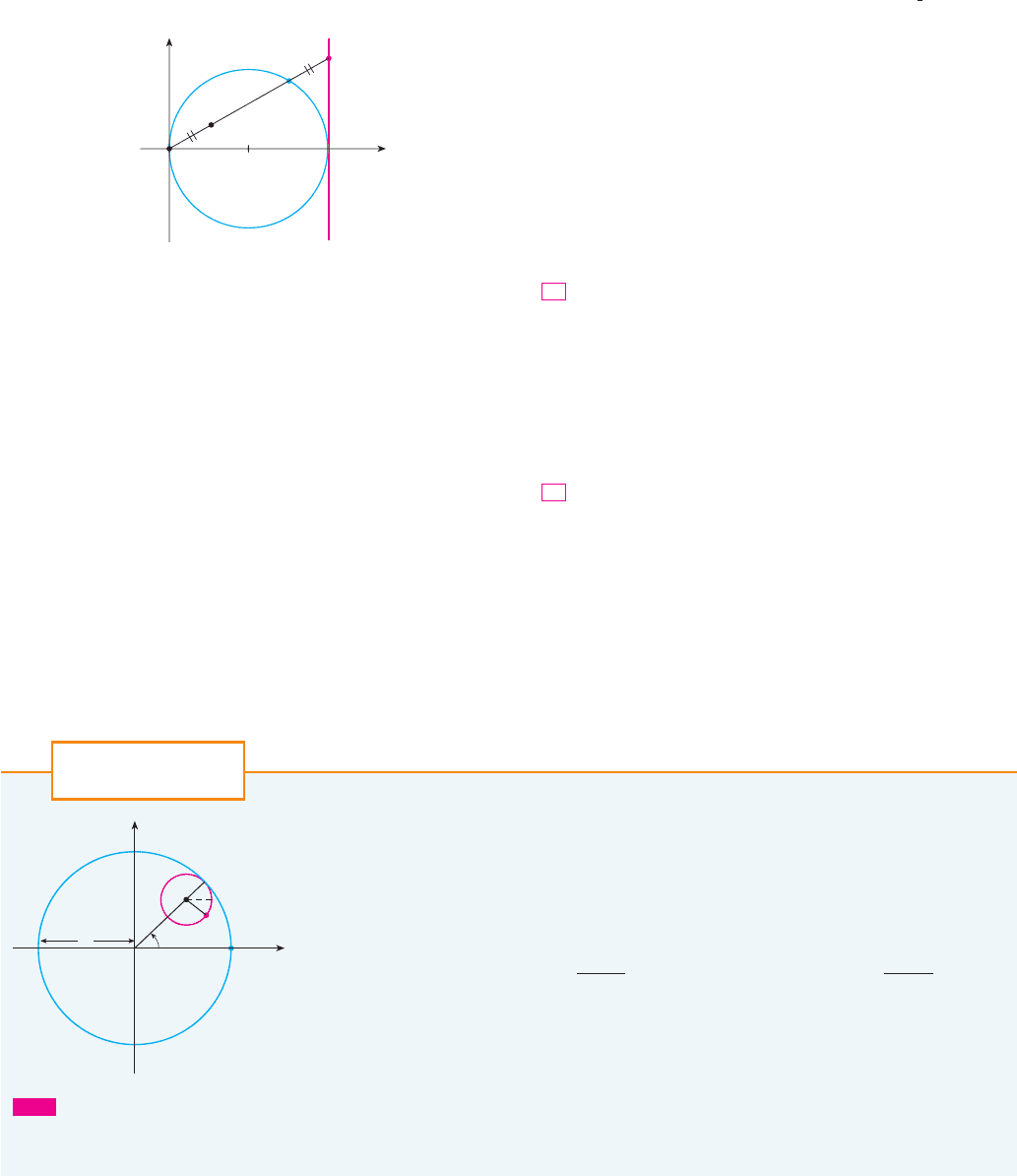
LABORATORY PROJECT RUNNING CIRCLES AROUND CIRCLES
|| ||
665
given by the parametric equations
where is the acceleration due to gravity ( m%s ).
(a) If a gun is fired with and m%s, when
will the bullet hit the ground? How far from the gun will
it hit the ground? What is the maximum height reached
by the bullet?
;
(b) Use a graphing device to check your answers to part (a).
Then graph the path of the projectile for several other
values of the angle to see where it hits the ground.
Summarize your findings.
(c) Show that the path is parabolic by eliminating the
parameter.
;
Investigate the family of curves defined by the parametric
equations , . How does the shape change
as increases? Illustrate by graphing several members of the
family.
;
48. The swallowtail catastrophe curves are defined by the para-
metric equations , . Graph
several of these curves. What features do the curves have
in common? How do they change when increases?
;
The curves with equations , are
called Lissajous figures. Investigate how these curves vary
when , , and vary. (Take to be a positive integer.)
;
50. Investigate the family of curves defined by the parametric
equations , , where . Start
by letting be a positive integer and see what happens to the
shape as increases. Then explore some of the possibilities
that occur when is a fraction.c
c
c
c ' 0y ! sin t ! sin ctx ! cos t
nnba
y ! b cos tx ! a sin nt
49.
c
y ! !ct
2
" 3t
4
x ! 2ct ! 4t
3
c
y ! t
3
! ctx ! t
2
47.
)
v
0
! 500
)
! 30*
2
9.8t
y ! "
v
0
sin
)
#t !
1
2
tt
2
x ! "v
0
cos
)
#t
(b) Use the geometric description of the curve to draw a
rough sketch of the curve by hand. Check your work by
using the parametric equations to graph the curve.
;
45. Suppose that the position of one particle at time is given by
and the position of a second particle is given by
(a) Graph the paths of both particles. How many points of
intersection are there?
(b) Are any of these points of intersection collision points?
In other words, are the particles ever at the same place at
the same time? If so, find the collision points.
(c) Describe what happens if the path of the second particle
is given by
46. If a projectile is fired with an initial velocity of meters per
second at an angle above the horizontal and air resistance
is assumed to be negligible, then its position after seconds is t
)
v
0
x
2
! 3 " cos t y
2
! 1 " sin t 0 $ t $ 2
#
0 $ t $ 2
#
y
2
! 1 " sin tx
2
! !3 " cos t
0 $ t $ 2
#
y
1
! 2 cos tx
1
! 3 sin t
t
x
O
y
A
P
x=2a
B
a
In this project we investigate families of curves, called hypocycloids and epicycloids, that are
generated by the motion of a point on a circle that rolls inside or outside another circle.
1. A hypocycloid is a curve traced out by a fixed point P on a circle C of radius b as C rolls on
the inside of a circle with center O and radius a. Show that if the initial position of P is
and the parameter is chosen as in the figure, then parametric equations of the hypocycloid
are
2. Use a graphing device (or the interactive graphic in TEC Module 11.1B) to draw the graphs
of hypocycloids with a a positive integer and b ! 1. How does the value of a affect the graph?
Show that if we take a ! 4, then the parametric equations of the hypocycloid reduce to
This curve is called a hypocycloid of four cusps, or an astroid.
y ! 4 sin
3
%
x ! 4 cos
3
%
y ! "a ! b# sin
%
! b sin
'
a ! b
b
%
(
x ! "a ! b# cos
%
" b cos
'
a ! b
b
%
(
%
"a, 0#
;
RUNNING CIRCLES AROUND CIRCLES
L A B O R A T O R Y
P R O J E C T
x
O
y
a
C
P
b
(a, 0)
¨
A
Look at Module 11.1B to see how
hypocycloids and epicycloids are formed by
the motion of rolling circles.
TE C

666
|| ||
CHAPTER 11 PARAMETRIC EQUATIONS AND POLAR COORDINATES
3. Now try b ! 1 and , a fraction where n and d have no common factor. First let n ! 1
and try to determine graphically the effect of the denominator d on the shape of the graph.
Then let n vary while keeping d constant. What happens when ?
4. What happens if and is irrational? Experiment with an irrational number like
or . Take larger and larger values for and speculate on what would happen if we
were to graph the hypocycloid for all real values of .
5. If the circle rolls on the outside of the fixed circle, the curve traced out by is called an
epicycloid. Find parametric equations for the epicycloid.
6. Investigate the possible shapes for epicycloids. Use methods similar to Problems 2–4.
PC
!
!
e " 2
s
2
ab ! 1
n ! d # 1
a ! n!d
CALCULUS WITH PARAMETRIC CURVES
Having seen how to represent curves by parametric equations, we now apply the methods
of calculus to these parametric curves. In particular, we solve problems involving tangents,
area, arc length, and surface area.
TANGENTS
In the preceding section we saw that some curves defined by parametric equations
and can also be expressed, by eliminating the parameter, in the form .
(See Exercise 67 for general conditions under which this is possible.) If we substitute
and in the equation , we get
and so, if , , and are differentiable, the Chain Rule gives
If , we can solve for :
Since the slope of the tangent to the curve at is , Equation 1
enables us to find tangents to parametric curves without having to eliminate the parameter.
Using Leibniz notation, we can rewrite Equation 1 in an easily remembered form:
It can be seen from Equation 2 that the curve has a horizontal tangent when
(provided that ) and it has a vertical tangent when (provided that
). This information is useful for sketching parametric curves.dy!dt " 0
dx!dt ! 0dx!dt " 0
dy!dt ! 0
dx
dt
" 0if
dy
dx
!
dy
dt
dx
dt
2
F$"x#"x, F"x##y ! F"x#
F$"x# !
t$"t#
f $"t#
1
F$"x#f $"t# " 0
t$"t# ! F$" f "t##f $"t# ! F$"x# f $"t#
fFt
t"t# ! F" f "t##
y ! F"x#y ! t"t#x ! f "t#
y ! F"x#y ! t"t#
x ! f "t#
11.2
N If we think of a parametric curve as being
traced out by a moving particle, then and
are the vertical and horizontal velocities
of the particle and Formula 2 says that the slope
of the tangent is the ratio of these velocities.
dx!dt
dy!dt
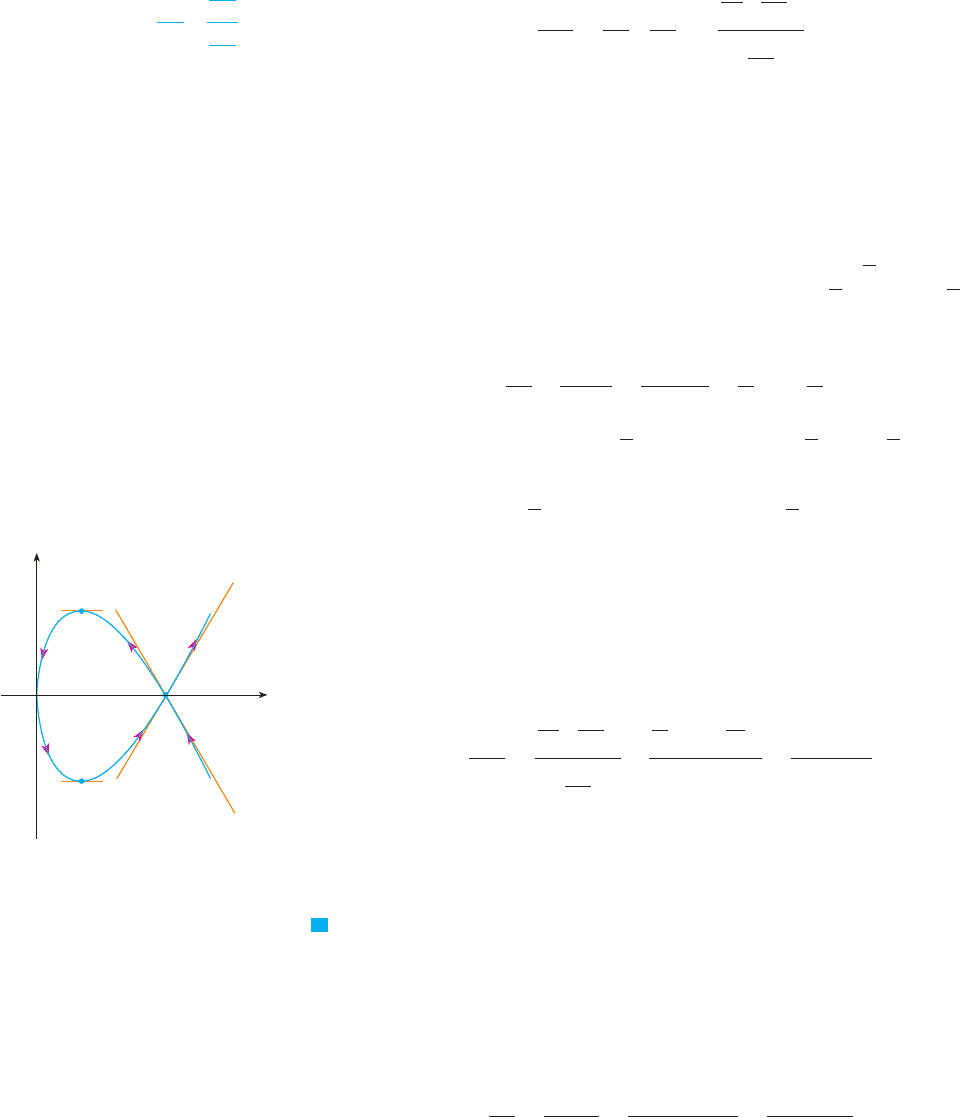
As we know from Chapter 4, it is also useful to consider . This can be found by
replacing y by dy!dx in Equation 2:
EXAMPLE 1 A curve is defined by the parametric equations ,
(a) Show that has two tangents at the point (3, 0) and find their equations.
(b) Find the points on where the tangent is horizontal or vertical.
(c) Determine where the curve is concave upward or downward.
(d) Sketch the curve.
SOLUTION
(a) Notice that when or . Therefore the
point on arises from two values of the parameter, and . This
indicates that crosses itself at . Since
the slope of the tangent when is , so the equa-
tions of the tangents at are
(b) has a horizontal tangent when , that is, when and .
Since , this happens when , that is, . The corresponding
points on are and (1, 2). has a vertical tangent when , that is,
. (Note that there.) The corresponding point on is (0, 0).
(c) To determine concavity we calculate the second derivative:
Thus the curve is concave upward when and concave downward when .
(d) Using the information from parts (b) and (c), we sketch in Figure 1.
M
EXAMPLE 2
(a) Find the tangent to the cycloid , at the point
where . (See Example 7 in Section 11.1.)
(b) At what points is the tangent horizontal? When is it vertical?
SOLUTION
(a) The slope of the tangent line is
dy
dx
!
dy!d
!
dx!d
!
!
r sin
!
r"1 " cos
!
#
!
sin
!
1 " cos
!
!
!
%
!3
y ! r "1 " cos
!
#x ! r "
!
" sin
!
#
V
C
t
&
0
t ' 0
d
2
y
dx
2
!
d
dt
$
dy
dx
%
dx
dt
!
3
2
$
1 #
1
t
2
%
2t
!
3"t
2
# 1#
4t
3
Cdy!dt " 0t ! 0
dx!dt ! 2t ! 0C"1, "2#C
t ! (1t
2
! 1dy!dt ! 3t
2
" 3
dx!dt " 0dy!dt ! 0dy!dx ! 0C
y ! "
s
3
"x " 3#andy !
s
3
"x " 3#
"3, 0#
dy!dx ! (6!
(
2
s
3
)
! (
s
3
t ! (
s
3
dy
dx
!
dy!dt
dx!dt
!
3t
2
" 3
2t
!
3
2
$
t "
1
t
%
"3, 0#C
t ! "
s
3
t !
s
3
C"3, 0#
t ! (
s
3
t ! 0y ! t
3
" 3t ! t"t
2
" 3# ! 0
C
C
y ! t
3
" 3t.x ! t
2
C
d
2
y
dx
2
!
d
dx
$
dy
dx
%
!
d
dt
$
dy
dx
%
dx
dt
d
2
y!dx
2
|
Note that
d
2
y
dx
2
"
d
2
y
dt
2
d
2
x
dt
2
SECTION 11.2 CALCULUS WITH PARAMETRIC CURVES
|| ||
667
0
y
x
(3, 0)
(1,_2)
(1, 2)
t=1
t=_1
y=œ
„
3(x-3)
y=_ œ
„
3(x-3)
F I G U R E 1
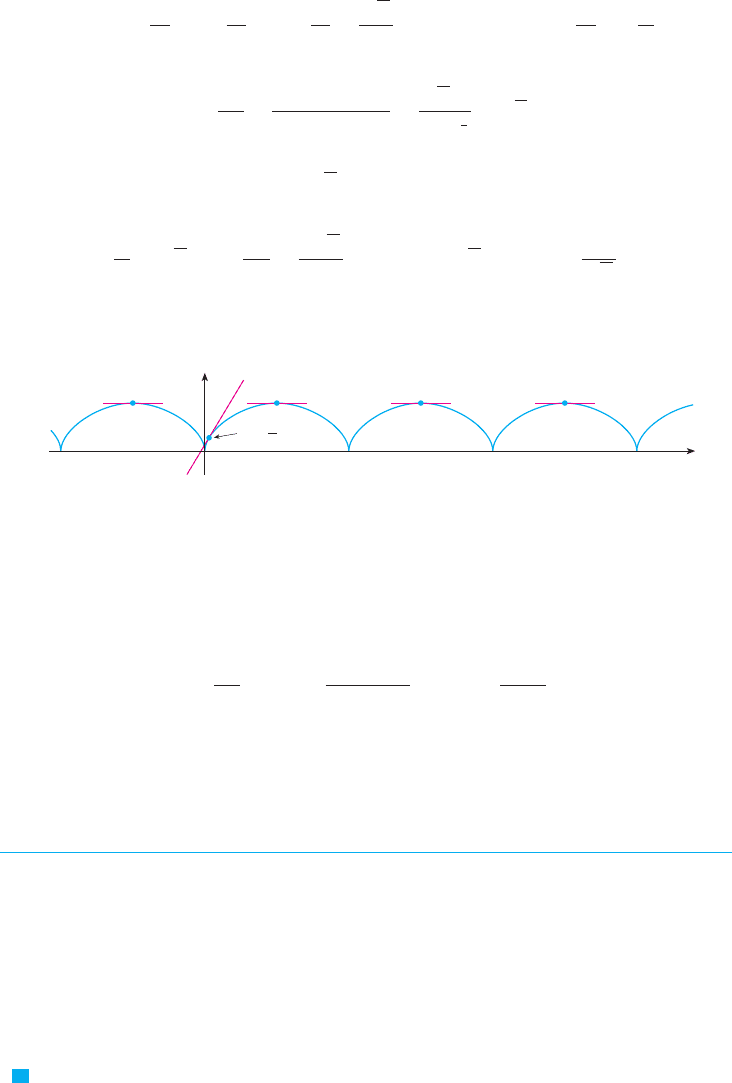
When , we have
and
Therefore the slope of the tangent is and its equation is
The tangent is sketched in Figure 2.
(b) The tangent is horizontal when , which occurs when and
, that is, , an integer. The corresponding point on the
cycloid is .
When , both and are 0. It appears from the graph that there are
vertical tangents at those points. We can verify this by using l’Hospital’s Rule as follows:
A similar computation shows that as , so indeed there are verti-
cal tangents when , that is, when .
M
AREAS
We know that the area under a curve from to is , where
. If the curve is traced out once by the parametric equations and ,
, then we can calculate an area formula by using the Substitution Rule for
Definite Integrals as follows:
EXAMPLE 3 Find the area under one arch of the cycloid
(See Figure 3.)
y ! r "1 " cos
!
#x ! r "
!
" sin
!
#
V
&
or
y
)
*
t"t# f $"t# dt
'
A !
y
b
a
y dx !
y
*
)
t"t# f $"t# dt
)
+ t +
*
y ! t"t#x ! f "t#F"x# , 0
A ! x
b
a
F"x# dxbay ! F"x#
x ! 2n
%
r
!
! 2n
%
!
l 2n
%
"
dy!dx l "-
lim
!
l
2n
%
#
dy
dx
! lim
!
l
2n
%
#
sin
!
1 " cos
!
! lim
!
l
2n
%
#
cos
!
sin
!
! -
dy!d
!
dx!d
!
!
! 2n
%
""2n " 1#
%
r, 2r#
n
!
! "2n " 1#
%
1 " cos
!
" 0
sin
!
! 0dy!dx ! 0
F I G U R E 2
0
y
x2πr 4πr
(πr,2r)(_πr,2r) (3πr,2r) (5πr,2r)
π
3
¨=
s
3
x " y ! r
$
%
s
3
" 2
%
ory "
r
2
!
s
3
$
x "
r
%
3
#
r
s
3
2
%
s
3
dy
dx
!
sin"
%
!3#
1 " cos"
%
!3#
!
s
3
!2
1 "
1
2
!
s
3
y ! r
$
1 " cos
%
3
%
!
r
2
x ! r
$
%
3
" sin
%
3
%
! r
$
%
3
"
s
3
2
%
!
!
%
!3
668
|| ||
CHAPTER 11 PARAMETRIC EQUATIONS AND POLAR COORDINATES
N The limits of integration for are found as
usual with the Substitution Rule. When
is either . When is the
remaining value.
x ! b, t
)
or
*
t
x ! a,
t
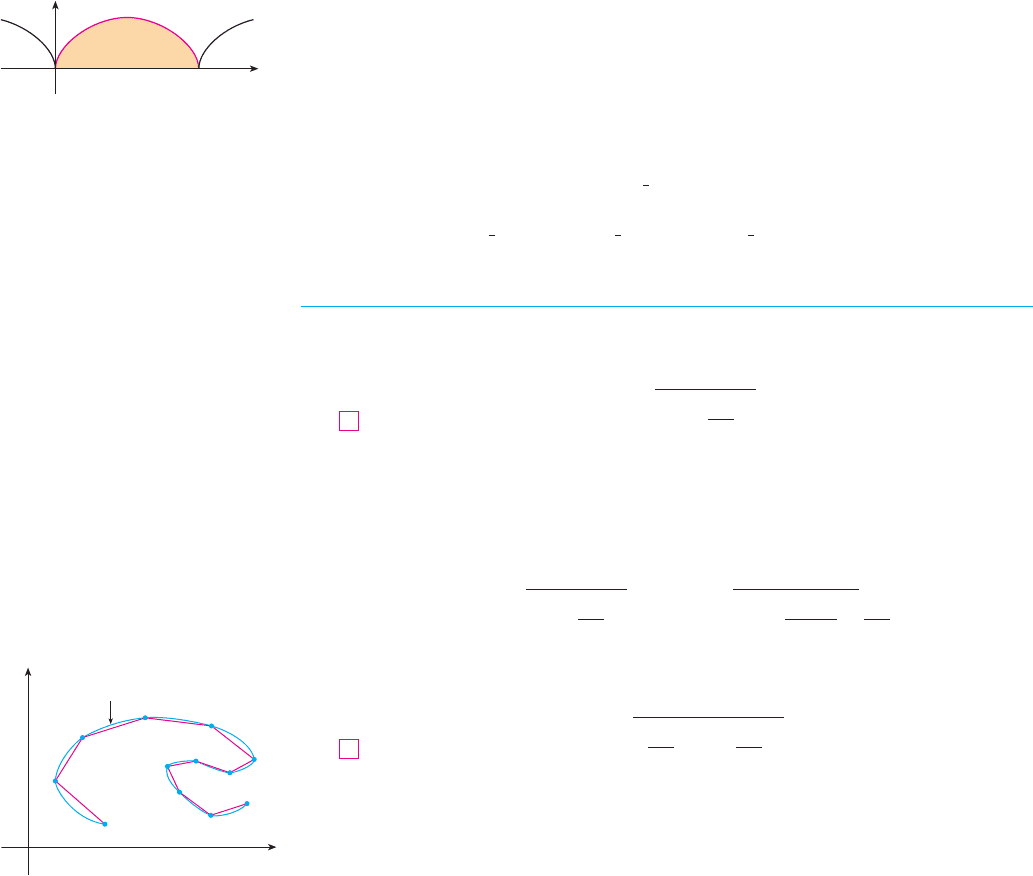
SOLUTION One arch of the cycloid is given by . Using the Substitution Rule
with and , we have
M
ARC LENGTH
We already know how to find the length of a curve given in the form ,
. Formula 9.1.3 says that if is continuous, then
Suppose that can also be described by the parametric equations and ,
, where . This means that is traversed once, from left to
right, as increases from to and , . Putting Formula 2 into Formula
3 and using the Substitution Rule, we obtain
Since , we have
Even if can’t be expressed in the form , Formula 4 is still valid but we obtain
it by polygonal approximations. We divide the parameter interval into n subintervals
of equal width . If , , , . . . , are the endpoints of these subintervals, then
and are the coordinates of points that lie on and the polygon with ver-
tices , , . . . , approximates . (See Figure 4.)
As in Section 9.1, we define the length of to be the limit of the lengths of these
approximating polygons as :
The Mean Value Theorem, when applied to on the interval , gives a number in
such that
If we let and , this equation becomes
.x
i
! f $"t
i
*
# .t
.y
i
! y
i
" y
i"1
.x
i
! x
i
" x
i"1
f "t
i
# " f "t
i"1
# ! f $"t
i
*
#"t
i
" t
i"1
#
"t
i"1
, t
i
#
t
i
*
(t
i"1
, t
i
)f
L ! lim
nl
-
*
n
i!1
+
P
i"1
P
i
+
n l -
CL
CP
n
P
1
P
0
CP
i
"x
i
, y
i
#y
i
! t"t
i
#
x
i
! f "t
i
#t
n
t
2
t
1
t
0
.t
(
)
,
*
)
y ! F"x#C
L !
y
*
)
,
$
dx
dt
%
2
#
$
dy
dt
%
2
dt
4
dx!dt ' 0
L !
y
b
a
,
1 #
$
dy
dx
%
2
dx !
y
*
)
,
1 #
$
dy!dt
dx!dt
%
2
dx
dt
dt
f "
*
# ! bf "
)
# ! a
*
)
t
Cdx!dt ! f $"t# ' 0
)
+ t +
*
y ! t"t#x ! f "t#C
L !
y
b
a
,
1 #
$
dy
dx
%
2
dx
3
F$a + x + b
y ! F"x#CL
! r
2
(
3
2
! 2
%
)
! 3
%
r
2
! r
2
[
3
2
!
" 2 sin
!
#
1
4
sin 2
!
]
0
2
%
! r
2
y
2
%
0
[
1 " 2 cos
!
#
1
2
"1 # cos 2
!
#
]
d
!
! r
2
y
2
%
0
"1 " cos
!
#
2
d
!
! r
2
y
2
%
0
"1 " 2 cos
!
# cos
2
!
# d
!
A !
y
2
%
r
0
y dx !
y
2
%
0
r"1 " cos
!
#
r"1 " cos
!
# d
!
dx ! r"1 " cos
!
#
d
!
y ! r "1 " cos
!
#
0 +
!
+ 2
%
SECTION 11.2 CALCULUS WITH PARAMETRIC CURVES
|| ||
669
N The result of Example 3 says that the area
under one arch of the cycloid is three times the
area of the rolling circle that generates the
cycloid (see Example 7 in Section 10.1). Galileo
guessed this result but it was first proved by the
French mathematician Roberval and the Italian
mathematician Torricelli.
F I G U R E 3
0
y
x
2πr
0
y
x
P¸
P¡
P™
P
i_ 1
P
i
P
n
C
F I G U R E 4

Similarly, when applied to , the Mean Value Theorem gives a number in such
that
Therefore
and so
The sum in (5) resembles a Riemann sum for the function but it is not
exactly a Riemann sum because in general. Nevertheless, if and are contin-
uous, it can be shown that the limit in (5) is the same as if and were equal, namely,
Thus, using Leibniz notation, we have the following result, which has the same form as
Formula (4).
THEOREM If a curve is described by the parametric equations ,
, , where and are continuous on and is traversed
exactly once as increases from to , then the length of is
Notice that the formula in Theorem 6 is consistent with the general formulas
and of Section 9.1.
EXAMPLE 4 If we use the representation of the unit circle given in Example 2 in Sec-
tion 11.1,
then and , so Theorem 6 gives
as expected. If, on the other hand, we use the representation given in Example 3 in Sec-
tion 11.1,
then , , and the integral in Theorem 6 gives
y
2
%
0
,
$
dx
dt
%
2
#
$
dy
dt
%
2
dt !
y
2
%
0
s
4 cos
2
2t # 4 sin
2
2t
dt !
y
2
%
0
2 dt ! 4
%
dy!dt ! "2 sin 2tdx!dt ! 2 cos 2t
0 + t + 2
%
y ! cos 2tx ! sin 2t
!
y
2
%
0
dt ! 2
%
L !
y
2
%
0
,
$
dx
dt
%
2
#
$
dy
dt
%
2
dt !
y
2
%
0
s
sin
2
t # cos
2
t
dt
dy!dt ! cos tdx!dt ! "sin t
0 + t + 2
%
y ! sin tx ! cos t
"ds#
2
! "dx#
2
# "dy#
2
L ! x ds
L !
y
*
)
,
$
dx
dt
%
2
#
$
dy
dt
%
2
dt
C
*
)
t
C(
)
,
*
)t$f $
)
+ t +
*
y ! t"t#
x ! f "t#C
6
L !
y
*
)
s
( f $"t#)
2
# (t$"t#)
2
dt
t
i
**
t
i
*
t$f $t
i
*
" t
i
**
s
( f $"t#)
2
# (t$"t#)
2
L ! lim
n
l
-
*
n
i!1
s
( f $"t
i
*
#)
2
# (t$"t
i
**
#)
2
.t
5
!
s
( f $"t
i
*
#)
2
# (t$"t
i
**
#)
2
.t
!
s
( f $"t
i
*
#.t)
2
# (t$"t
i
**
#.t)
2
+
P
i"1
P
i
+
!
s
".x
i
#
2
# ".y
i
#
2
.y
i
! t$"t
i
**
# .t
"t
i"1
, t
i
#t
i
**
t
670
|| ||
CHAPTER 11 PARAMETRIC EQUATIONS AND POLAR COORDINATES

|
Notice that the integral gives twice the arc length of the circle because as increases
from 0 to , the point traverses the circle twice. In general, when finding
the length of a curve from a parametric representation, we have to be careful to ensure
that is traversed only once as increases from to .
M
EXAMPLE 5 Find the length of one arch of the cycloid ,
SOLUTION From Example 3 we see that one arch is described by the parameter interval
. Since
we have
To evaluate this integral we use the identity with , which
gives . Since , we have and so
. Therefore
and so
M
SURFACE AREA
In the same way as for arc length, we can adapt Formula 9.2.5 to obtain a formula for
surface area. If the curve given by the parametric equations , , ,
is rotated about the -axis, where , are continuous and , then the area of the
resulting surface is given by
The general symbolic formulas and (Formulas 9.2.7 and
9.2.8) are still valid, but for parametric curves we use
EXAMPLE 6 Show that the surface area of a sphere of radius is .
SOLUTION The sphere is obtained by rotating the semicircle
0 + t +
%
y ! r sin tx ! r cos t
4
%
r
2
r
ds !
,
$
dx
dt
%
2
#
$
dy
dt
%
2
dt
S !
x 2
%
x dsS ! x 2
%
y ds
S !
y
*
)
2
%
y
,
$
dx
dt
%
2
#
$
dy
dt
%
2
dt
7
t"t# , 0t$f $x
)
+ t +
*
y ! t"t#x ! f "t#
! 2r (2 # 2) ! 8r
L ! 2r
y
2
%
0
sin"
!
!2# d
!
! 2r("2 cos"
!
!2#
]
0
2
%
s
2"1 " cos
!
# !
s
4 sin
2
"
!
!2# ! 2
+
sin"
!
!2#
+
! 2 sin"
!
!2#
sin"
!
!2# , 0
0 +
!
!2 +
%
0 +
!
+ 2
%
1 " cos
!
! 2 sin
2
"
!
!2#
!
! 2xsin
2
x !
1
2
"1 " cos 2x#
!
y
2
%
0
s
r
2
"1 " 2 cos
!
# cos
2
!
# sin
2
!
#
d
!
! r
y
2
%
0
s
2"1 " cos
!
#
d
!
L !
y
2
%
0
,
$
dx
d
!
%
2
#
$
dy
d
!
%
2
d
!
!
y
2
%
0
s
r
2
"1 " cos
!
#
2
# r
2
sin
2
!
d
!
dy
d
!
! r sin
!
and
dx
d
!
! r"1 " cos
!
#
0 +
!
+ 2
%
y ! r"1 " cos
!
#.
x ! r "
!
" sin
!
#
V
*
)
tC
C
"sin 2t, cos 2t#2
%
t
SECTION 11.2 CALCULUS WITH PARAMETRIC CURVES
|| ||
671
N The result of Example 5 says that the length of
one arch of a cycloid is eight times the radius of
the generating circle (see Figure 5). This was first
proved in 1658 by Sir Christopher Wren, who
later became the architect of St. Paul’s Cathedral
in London.
F I G U R E 5
0
y
x2πr
r
L=8r
